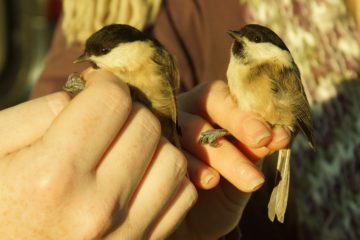We undertook two ringing sessions near my house this month catching 19 new birds and 10 retraps on the 10th, and 32 new birds with 13 re-traps on the 20th. The most notable bird was a re-trapped male Redpoll (APB7555) on the 20th; with its very narrow sharp shaped tail it looked like a juvenile bird but as it was a re-trap I was soon able to discover it had originally been ringed in April 2018 as a second-year bird of unknown sex (with just a little red on its breast) in company with several siskins. Hence it was actually over two years old and we can only presume that it’s been travelling since it was originally ringed (see attached photo). There were also two re-trap Coal Tits, both from 2017 (which unlike the Redpoll had been re-tapped several times before). Some birders (especially compulsive listers and splitters) will no doubt question ‘which’ particular variety of redpoll it was but recent genetic research is suggesting that while the rarer Artic Redpoll is a very distinct species; those birds that used to be dubiously split between Lesser & Mealy are in fact so closely related that they should be treated as one species i.e. Redpoll.

This month we also returned to our site near Longhorsley were both our rare tits (Willow and Marsh) have been found in the past. We first set up on the 1st and captured 38 new birds and 5 re-traps, including the expected Blue, Coal and Great Tits; some Tree Sparrows, House Sparrows, Wren and Nuthatch. There was also two new juvenile Willow Tits, confirming of course that this species had bred successfully at this site again. There were also two re-trapped adult Willow Tits: AYE1026 from 23/12/18 and AYE1027 from 9/12/18 (possibly the parent birds). See attached photo of two Willow Tits. Returning on the 7th we captured another 35 new birds and 10 re-traps; this time including an older adult Willow Tit from 16/2/18 when it was already a second-year bird.
However, we had not up to this point encountered a single Marsh Tit but when putting up a net on the 18th I heard very distinctly the two-note ‘pitchoo’ call close by. It was an hour later that we actually captured a ‘re-trap’ adult Marsh Tit (APB7702) first ringed on the 26/1/18 (photo attached). We also recaptured a ‘new’ adult Willow Tit from 9/12/18 and two of the Willow Tits already seen this December. So far, we can’t confirm that any Marsh Tits have successfully nested at this site in 2019. However, we hope to return to this site again soon.
With the help of my son, I have also undertaken some analysis of this years ringing at Howick (in the arboretum). Between the end of July and the start of November we undertook 22 ringing sessions and captured a total of 987 birds of which 717 were new (together with 270 re-traps). The weather was not over-kind and several sessions were curtailed or started late but this is still better than we did in 2018 but almost the same numbers as in 2017. Blackbird numbers were up at 20 new (compared with only 4 in 2018); and Blue Tits were up to 148 (compared to 114 in 2017 and 115 in 2018) suggested that Blue Tits had a more successful breeding year. We captured a new Brambling for the first time in two years and Bullfinch numbers were up at 26 compared to the low of 13 in 2018 (but still not as high as the 51 in 2017). Goldfinch numbers were down at 56, compared with the high of 80 in 2018 (but still more that the low of 32 in 2017) and Greenfinch were again scarce with only 7 new ones ringed (and no re-traps). We captured only 26 Goldcrest; which was more than the dismal 5 in 2018 but a lot less than the record numbers of 86 in 2017. The explanation of this is almost certain that the ‘26’ represents mostly resident birds while they’re was a major influx of migrants during the autumn of 2017. Mistle Thrush were only on 12, compared with 21 in 2018 (of which some were probably incoming migrants) and Redwing totalled only 3 being quite late migrants this year. Our rare Yellow-browed Warblers totalled 2 coming in ‘on-time’ on the 3rd & 5th October!
Turning to ‘African’ migrants we ringed 64 new Chiffchaffs (compared to only 41 in 2018) but only 5 Willow Warblers (compared to 17 in 2018). Blackcaps were down to 36 (compared to 88 in 2017 and 45 in 2018); while Garden Warblers were up at 3 (compared to none in 2018 and 2 in 2017).
I am going out to help study some of ‘our’ migrants in their warmer winter quarters in Africa soon; having just had my Anti-Rabies Booster injection!
If interested in ringing please get in touch. Phil Hanmer ‘A’ Ringer/Trainer; Natural History Society of Northumbria Ringing Group (Hancock Museum). E-mail: tytoalbas@btinternet.com